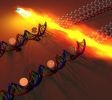At Stanford, Russian and his colleagues turn DNA into basis for carbon transistors
 Anatoliy N. Sokolov, a Russian scientist working at Stanford, and other local physicists have developed a method of obtaining carbon transistors by ?charring? DNA strands.
Anatoliy N. Sokolov, a Russian scientist working at Stanford, and other local physicists have developed a method of obtaining carbon transistors by ?charring? DNA strands.Anatoliy N. Sokolov, a Russian scientist working at Stanford, and other local physicists have developed a method of obtaining carbon transistors by ?charring? DNA strands, Lenta.ru reported. The technique was described in Nature Communications, an international scientific online journal. The research team is said to have aimed to use DNA as a basis for growing nanoscopic graphitic nanoribbons up to 10 nanometers in width (several atoms thick) and a few micrometers in length in special chemical vapor deposition conditions. During the experiments, bacterial DNA was placed to a silicon substrate where the spiral nucleic acid strands were stretched to become almost straight. The DNA-containing substrate was then moved into a methane-containing vacuum-sealed chamber and heated...
Похожее
Russians and Americans create ultra-thin material for nano-capacitors
In Moscow, new brake disks developed for next gen Russian aircraft
Ural scientist joins Nature?s 2013 Top 10 of global world-changing researchers
Moscow students present carbon plastic-based racing car and bike
A scientist from Tomsk developed an ATM keypad which scrambles the code
Moscow physicists offer jewelers innovation diamond marking techniques